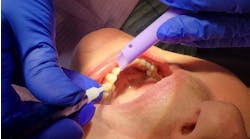New Year’s Day is coming, and many health-care and dental hygiene professionals are wondering how they can encourage young patients to stay healthy and keep their teeth clean and cavity-free.
Parents and dental professionals alike usually convince younger people to do something or not do something in one of two ways:
- Inspire with encouragement and hope
- Frighten with warnings and examples
In other words, parents and dental professionals take on the stereotypical good cop and bad cop. Let’s theoretically take a look at both methods and see what works and what does not.
Good cop ...
To get younger patients to understand the importance of brushing and flossing their teeth by using the good cop method, dental professionals will try to encourage and reward and instill hope. With the good cop method, you might say things like, “Here is a brand new toothbrush for you to use at least twice every day,” and “Here is some sugar-free gum, or a prize, because you did not have any cavities. Keep those cavities away by brushing your teeth so you can get another prize the next time you visit our dental office.” The point is to give something new ... some kind of reward to instill the idea that having clean teeth and brushing one’s teeth will result in gifts such as sugar-free gum, new toothbrushes, and prizes.
The advantages in using this method are: one does not have to be the bad guy, it is fun to reward good behavior, and the patient leaves happy.
The downside of using this method is: the result of a small reward or prize may not be enough to have any lasting impact.
Bad cop ...
To get younger patients to understand the dangers of not taking care of their teeth, dental professionals who use the bad copy method will try to warn and sometimes frighten in order to instill a longer-lasting impact. These dental professionals will say things like, “Look at what happens when you do not brush your teeth,” while showing pictures of rotten and decayed teeth, or “Remember how much that cavity hurt? You don’t want to be in that much pain again, do you?” They rely on these tactics to remind younger patients of the pain that ensues when they do not take care of their teeth.
The advantages of using this method are: the impact of seeing damaged teeth and the realization that this is what could happen when one does not care for his or her teeth. These enlightenments are usually enough to motivate patients to stay with good oral health habits longer.
The downside of using this method is: one has to be the bad guy by inflicting fear or by causing the patient to remember pain.
Author bio
Dr. David Maisey is an expert dentist who founded the Toothbrush Nanny site in order to provide people with new toothbrushes on a regular basis.





